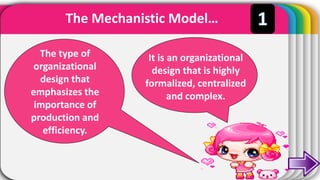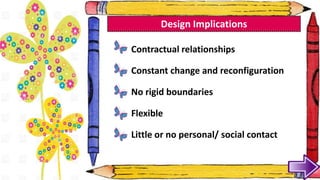Organizational Structure and Design
- 1. Mary Krystle Dawn Denosta Sulleza Reporter
- 5. The Mechanistic Model… The type of organizational design that emphasizes the importance of production and efficiency. It is an organizational design that is highly formalized, centralized and complex.
- 6. Fayor’s Principle for Mechanistic Model The Principle of Specialization The Principle of Unity of Direction The Principle of Authority and Responsibility The Scalar Chain Principle Bureaucracy
- 7. Characteristics to achieve the maximum benefits of the Bureaucratic Design All tasks will be divided into highly specialized jobs Each task is performed according to a system of abstract rules to ensure uniformity and coordination of different tasks. Each member or office of the organization is accountable for job performance to one, and only one, manager. Each employee of the organization relates to other employees and clients in an impersonal, formal manner, maintaining a social distance with subordinates and clients. Employment in the bureaucratic organization is based on technical qualifications and is protected against arbitrary dismissal.
- 8. Structural Characteristics to Achieve High Levels of Production and Efficiency It’s highly complex because of its emphasis on specialization of labor. It’s highly centralized because of its emphasis on authority and accountability. It’s highly formalized because of its emphasis on function as the basis for departments.
- 10. The Organic Model… The type of organizational design that emphasizes the importance of adaptability and development. It is relatively informal, decentralized, and simple.
- 11. Characteristics of Organic Model It’s relatively simple because of its de-emphasis of specialization and its emphasis on increasing job range. It’s relatively decentralized because of its emphasis on delegation of authority and increasing job depth. It’s relatively informal because of its emphasis on product and customer as bases for departments.
- 13. The Matrix Model… The type of organizational design that superimposes a product-or-project- based design on an existing function- based design
- 14. Characteristics of Matrix Model Requires responses to rapid change in two or more environments, such as technology and markets. Face uncertainties that generate high information processing requirements Must deal with financial and human resources constraints.
- 15. Advantages of Matrix Organizations… Efficient use of Resources. Flexibility in conditions of Change and Uncertainty Technical Excellence Freeing Top Management for Long-Range Planning Improving Motivation and Commitment Providing Opportunities for Personal Development
- 16. Different Forms of Matrix Organizations Task Force Teams Product Managers Product Management Departments
- 17. National boundaries are an important force in defining organizational environments. Subsidiaries or affiliates of multinational corporations can act as conduits that introduce changes into the host country’s environment. Subsidiaries or affiliates of multinational corporations can act as conduits through which features of the host country culture are introduced throughout the multinational organization. Factors that have implications for structure and Design Decisions
- 21. Personnel distributed geographically Electronically connected Differences in expertise and function Culturally diverse Work schedule differences Horizontally arranged with little emphasis on command and control authority. Factors in Design Considerations
- 22. Contractual relationships Constant change and reconfiguration No rigid boundaries Flexible Little or no personal/ social contact Design Implications
- 23. Increase in overall communication and messages Relationships are tenuous Continual surety of roles, tasks, and assignments Caution needed in managing feedback, discussion, performance review, and reward systems Greater equity of participation Consequences
- 24. Boundaryless Organizations A firm in which chains of command are eliminated, spans of control are unlimited, and rigid departments are replaced with empowered teams.
- 25. Characteristics of a Boundaryless Organization There is still hierarchy but there is less distance, less separation between top-level managers and employees. There is an emphasis on participative decision making, multiple hierarchy teams, team building, and coordination. The effective boundaryless organization breaks down barriers with external constituents and distance. Conceptually, the boundaryless organization involves breaking down of structure, hierarchy, specific roles, and distance.


























